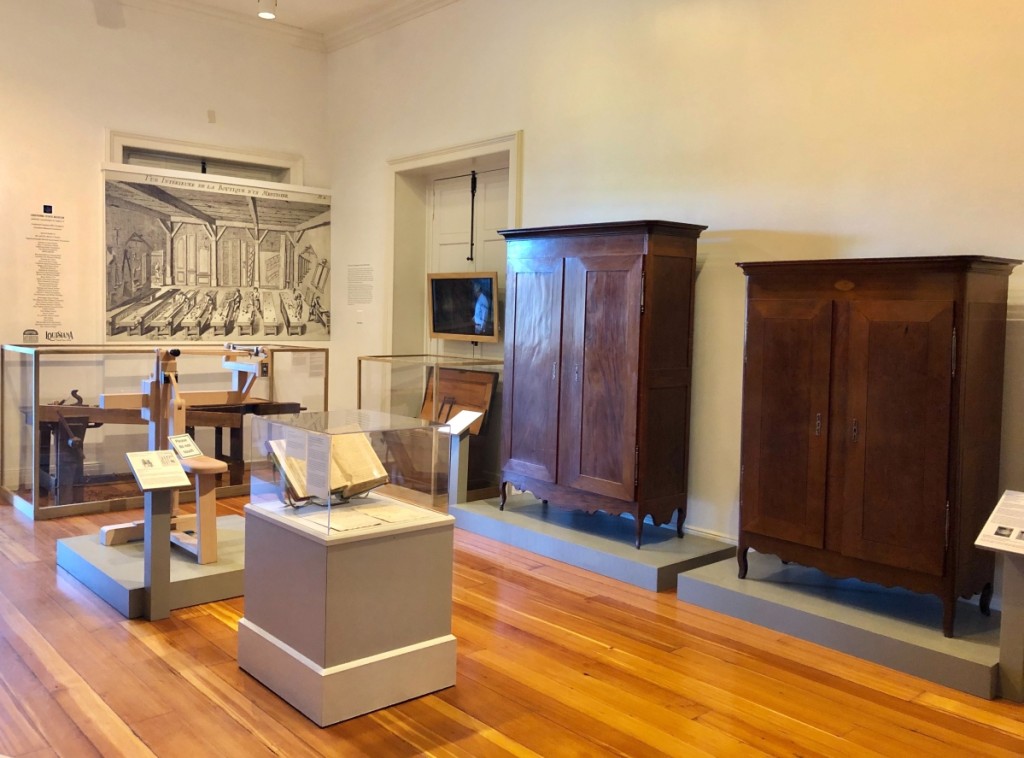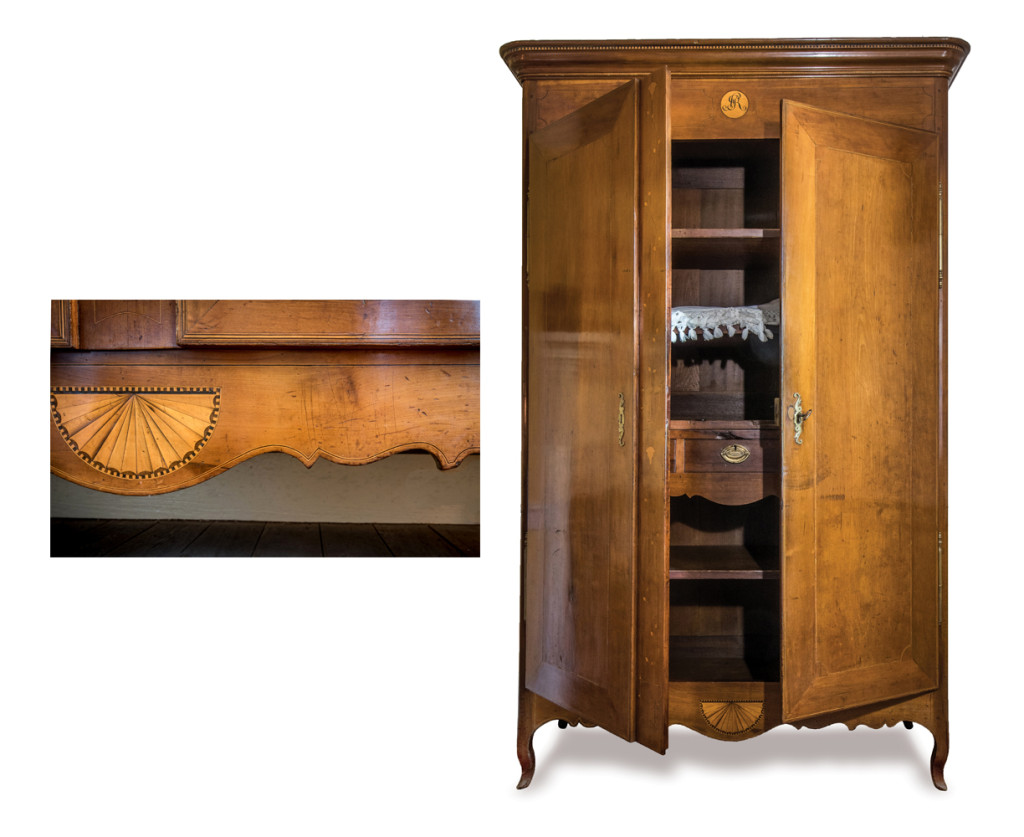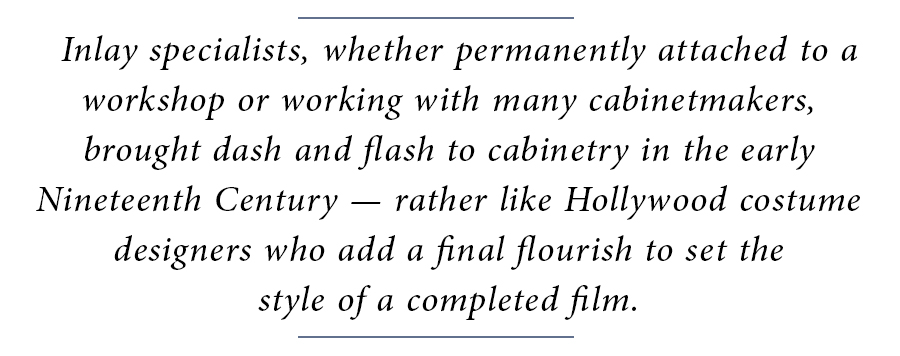
An installation view shows two Butterfly Man armoires along with objects that demonstrate their context. The left back wall displays a reproduction of “Vue Interieure de la Boutique d’un Menuisier,” an engraved image that appears in André Jacob Roubo’s L’Art du Menuisier, featuring elements of a cabinetmaker’s workshop in the late Eighteenth Century. Beneath it is a Nineteenth Century cabinetmakers bench along with period tools.
By Karla Klein Albertson
NEW ORLEANS, LA. – All exhibitions are long-term projects, opening only after years of planning. Arrangements are carefully worked out for the loan of precious artworks and designs are drawn up for their innovative installation. After all that hard work, some shows turn out to be just reunions of material tied together by an artist or theme, while others reveal impressive results from original research, which is then illustrated by the exhibits on display.
Such an exhibition is “Chasing the Butterfly Man: The Search for a Lost New Orleans Cabinetmaker, 1810-1825” on view through August 15 in the historic Cabildo on Jackson Square in the heart of the French Quarter. The show explores the aesthetics of a small group of armoires that reveal the anonymous master’s distinctive cabinetry construction as well as the technical clues that link his body of work. The details and depth of the research are recorded in the excellent volume which accompanies the exhibition and will remain a valuable reference in the field of early Nineteenth Century American furniture.
The researcher, curator and catalog author in this case is Cybele Gontar, whom readers will remember as the driving force behind the 2018 exhibition and book on New Orleans portrait painter Josef Francisco Xavier de Salazar y Mendoza (1750-1802). The show at the Ogden Museum of Southern Art was the subject of a cover story on June 29 of that year, which happened to be the 300th anniversary of New Orleans.
Even before that painting study, Gontar was one of the authors of the long-awaited Furnishing Louisiana: Creole and Acadian Furniture, 1735-1835, published by the Historic New Orleans Collection in 2009. It was during the investigations for that reference that her research into a group of armoires made by the “Butterfly Man” began, and she has continued to gather information during the intervening decade. She said, “The Louisiana State Museum wanted me to come over there and do something for them. They had a place for a show in November, and I had amassed all this material over the past ten years. We had learned more about the Butterfly Man, and I wanted to do an exhibition on that. We raised the money for the show and the book and there we were.”
In a recent interview with Antiques and The Arts Weekly, Gontar discussed her fascination with the topic: “My inspiration is the mystery of it, the ongoing question – who made these things? We did Furnishing Louisiana, and some of these armoires had been damaged in Hurricane Katrina, that happened right in the middle of writing the book. I was invited by Dr Jack D. Holden, my co-author, to cabinetmaker Steven Huber’s studio in Natchez, Miss. When I walked in the door, I saw all these armoires taken apart, and they told me they were the ‘Butterfly Man’ armoires. I was fascinated with this idea – that they were so beautiful and we didn’t know who had made them. We were going to do an article for The Magazine Antiques in advance of the book coming out, and I thought we’ll do it about this man. I thought maybe I could solve this mystery and figure out who had made these objects. We did a preliminary study in the American furniture issue in May 2008 that was a careful examination of all the armoires made by him, while taking a good look at the construction. You can see where we were ten years ago.”
All of the cabinetmaker’s armoires are in private hands, so a visit to the Cabildo galleries is a rare opportunity to examine eight harmonious creations by this cabinetmaker at close range. The exhibition and its catalog follow a similar format. The first room is devoted to the history of the armoire, so that visitors can compare earlier armoire forms to the later neoclassical examples executed by the Butterfly Man. There are exhibits of period hardware, hinges, drawer pulls and escutcheons used in their construction. One armoire containing old textiles is displayed in a period bedroom setting with early prints and a Louisiana bed.
Turning to the print component, the accompanying volume is packed with information and a wealth of beautiful illustrations. In the introduction, Gontar explains how this maker got his nickname: “During the early Twentieth Century, prescient Louisiana collectors identified a small group of armoires (circa 1810-25) and named their anonymous maker the ‘Butterfly Man’ for his signature use of a commonplace butterfly-shaped joint, added to reinforce wood panels. Today, 17 armoires have been carefully studied and are proven to have been constructed in the Butterfly Man’s workshop, though his identity remains unknown. The Butterfly Man’s stylish cabinets, most bearing elaborate inlay patterns and book-matched door panels, represent the zenith of furniture craftsmanship in early Nineteenth Century Louisiana.”
Among the many important elements in the reference is an opening chapter on “The History of the Armoire,” which includes a discussion of the form from a Nineteenth Century Parisian dictionary of furniture by French art historian Henry Havard (1838-1921) with an English translation. The cabinets were not just clothes closets but could be used to store everything from silverware to books to weaponry. The chapter opens with an etching by Fragonard that shows a young lover being discovered after hiding in his sweetheart’s armoire. Other chapters discuss technical details of construction, historic documentation, New Orleans cabinetmakers, and which of these might actually be the Butterfly Man. Since they are all privately-owned, the catalog section, which ends the book, not only has images of the armoires and their decoration but also includes photos of the examples in situ at their regular place of residence in the historic homes of collectors. Primary woods used are walnut and cherry and mahogany for the finest pieces; interiors are fitted with shelves and bands of drawers for storage.
As is the case in all aspects of New Orleans style, the magic is in the mix of influences. Gontar writes: “In 1810, approximately 30 cabinetmakers practiced their trade in the French Quarter. By 1825, this number had doubled in tandem with the population due to the arrival of Saint-Dominguan (Haitian) émigrés and Americans who migrated after the Louisiana Purchase of 1803… Further, an influx of Anglo-Americans and northeastern goods in post-purchase Louisiana brought Federal taste to New Orleans. The creation of the Butterfly Man armoires, which are essentially French West Indian-style cabinets highlighted by intricate neoclassical urns and American eagles, synthesized these aesthetic and political influences.”

Distinctive scalloped front and side apron patterns function as the Butterfly Man’s signature. These patterns on several armoires match, indicating that they were cut simultaneously. The initials “SR” personalize this object and suggest that it commemorated a marriage. Detail, Butterfly Man armoire, New Orleans, circa 1810-25. Collection of Dr. and Mrs. Wayne Stromeyer, Baton Rouge, La. Photograph by John Dileo.
Inlay specialists, whether permanently attached to a workshop or working with many cabinetmakers, brought dash and flash to cabinetry in the early Nineteenth Century – rather like Hollywood costume designers who add a final flourish to set the style of a completed film. The relationship of inlay decoration to basic form is discussed thoroughly in the catalog entries on individual examples. Finding out who created the elaborate decoration is as difficult as identifying the cabinetmaker himself.
Bringing an informed perspective to the question, the volume includes an important chapter on “George Dewhurst, American Inlay Maker” by specialist Stephen P. Latta. Dewhurst came from England to Boston in 1801, moved on to Baltimore and Lexington, Ky., before arriving in New Orleans in 1817. The text explores the characteristics of Dewhurst’s personal style and concludes: “Attributing work to a contractor such as Dewhurst is not such an easy task, especially when supporting evidence appears scattered all along the eastern United States. Still, the fact remains that there exist two highly distinctive bandings that adorn pieces from Boston to New Orleans and their presence coincides with the travels of a single man. Coincidence or not, the matter merits our careful study.”
A visit to “Chasing the Butterfly Man” is a perfect reason for making a trip to New Orleans during the spring or summer; tropical weather and superb dining will add color to the experience. The exhibition is on view in the Cabildo (1795-1799), which was built as a seat of the Spanish municipal government in New Orleans; it is located to the left of St Louis Cathedral on Jackson Square. The venue is one of nine galleries and historic properties administered by the Louisiana State Museum; learn more at their website www.louisianastatemuseum.org or call 504-568-6968. The Butterfly Man catalogue may be ordered directly from the publisher, the Louisiana Museum Foundation, by contacting Valerie Vindici, the grants, contracts and program coordinator, at vvindici@thelmf.org.













